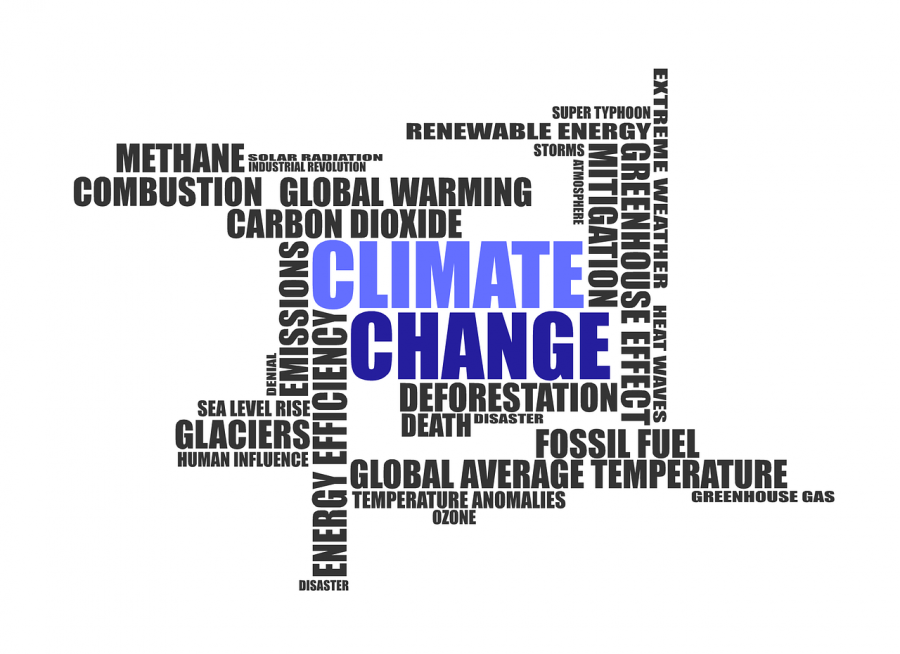What Do the Fires in Australia Mean for Delawareans?
A Climate Change Word Collage: A Testimony to its Universality
April 13, 2020
A group of kangaroos gathers in the brushland, grazing in their serene and quiet home. Their environment represents the archetype of peace. Shattered in an instant, however, the sky darkens as smoke chokes the life out of the air. A keening noise, a sound of fear as the kangaroos leap away, their shadows spiraling into the smoke. Then, a crackling, burning hiss, as flames explode into the quiet glade. The kangaroos have vanished, leaving behind those lying still in the charred and blackened grass. The once omnipresent peace has been burned away by pain and death.
Meanwhile, other animals are suffering a similar fate. It is estimated that one-third of the entire New South Wales koala population has been killed by the flames. Unfortunately, this sort of cataclysmic event isn’t just reserved for the Australian continent. The weather is getting warmer and more vicious as time progresses. Climate change is altering the weather patterns of the globe. Even here in Delaware, climate change will ultimately have drastic effects on our ways of life due to the prospect of extreme heat and inland flooding.
The Australian fires, which started in Autumn of 2019 after a record-breaking heatwave, have devastated the local wildlife and destroyed at least 2,500 homes. A terrible example of the damage the fires have done to the wildlife is on Kangaroo Island, where, according to The New York Times, the fires have burned about half the island and killed 40% of its kangaroo inhabitants.
Even worse, it is not only the species roaming the grounds that have been terribly affected by climate change’s consequent fires. Another species, the black cockatoo, had over thirty percent of its meager population of just over five hundred killed by the fires. Smaller animals, like echidnas, have survived the heat by going underground, but lose all their food in the chaos that ensues above them.
Beyond the actual flames of the fires, the smoke is almost as bad. In Australia’s capital, Canberra, the pollution levels measured hazardous or worse more than 20 times consistently. Walter Edgar, the owner of Around and About Travel, an Australian tour company, says, “Some of the days have been really, really bad. You basically open the windows of your house to the front door and you can smell the smoke. It’s the worst I’ve ever encountered in that sense.” Though there have been worse fires in Australia’s history, these particular fires were much more concentrated in places near the public, thus heightening their negative effects.
It’s not unusual for Australia to have fires; in fact, their fire season typically extends from late December to early January. What is unusual is how early the fires started and how fast they grew. This unusual intensity of the fires can be mostly attributed to climate change, which has caused average temperatures to rise every year and contributed to the drought that led to these massive fires. It is important to note, however, that these horrid environmental conditions wreaking havoc are true without climate change. However, the climate crisis has made them over 30% more likely to occur. The extreme heat that Australia had, which has been the hottest on record, was said to be about twice as likely now because of how humans and corporations have affected the climate. “In the beginning of December, we had snow in the mountains. At the end of December, those same areas were burning with fires. So in a matter of 20 days, you’ve gone from temperatures below 0˚C to temperatures above 40˚C,” says Mr.Edgar.
Climate change isn’t just affecting the weather in Australia, as mentioned previously. It has widespread impacts, with the potential to extend all the way to Delaware. According to the United States Environmental Protection Agency, the weather patterns in the US are expected to change in favor of an increased number of floods and droughts. Specifically, the number of dangerous heat days per year in Delaware is expected to increase five-fold by 2050. By this same time, the strength of inland flooding events is estimated to increase by 70%. Climate change is also affecting other aspects of our weather. For example, the number of Atlantic hurricanes and their intensity has gone up significantly since the late 1900s. This increase in hurricanes is caused by a variety of factors, such as rising sea levels and an increased amount of warm air, which both strengthen the power and duration of hurricanes.
Although this fire season has been devastating, Mr.Edgardpredicts that “the Australian bush and people should recover well from these fires.” The greatest loss from these fires is likely to be animals who, unlike many of the Australian plants, cannot just grow back at will after fires. In Delaware, climate change will cause storms to become more frequent and dangerous, and increased heat will have many debilitating and dangerous effects, such as dehydration and heatstroke. Children will be at a higher risk for heat-caused illness, as small children don’t effectively regulate their body temperatures. Higher heat will also increase the risk of insect-borne diseases, as many bugs are out more in the warmer months. Climate change is a very real and dangerous thing that will cause unprecedented damage to Delaware’s ecosystems, infrastructure, and agriculture as well as endanger children and destroy homes. The ravages the fires have inflicted on Australia offer an invaluable lesson: climate change is not isolated. It has the potential power to affect us right here in Delaware too.































